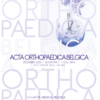Comparison of waterproof versus cotton cast liners on cast index in pediatric forearm fractures
cast index; forearm fracture; pediatric fracture; waterproof
Published online: Feb 17 2023
Abstract
Achieving an adequate cast mold is critical for successful nonoperative management of pediatric forearm fractures. A high cast index (>0.8) is as- sociated with an increased risk of loss of reduction and failure of conservative management. Waterproof cast liners offer improved patient satisfaction compared to conventional cotton liners, however they may carry different mechanical properties compared to traditional cotton liners. The purpose of this study was to determine whether the cast index differs between waterproof and traditional cotton cast liners when used to stabilize pediatric forearm fractures. We retrospectively reviewed all forearm fractures casted in a pediatric orthopedic surgeon’s clinic between December 2009 and January 2017. Either a waterproof or cotton cast liner was utilized according to parent and patient preferences. The cast index was determined on follow-up radiographs and compared between groups. Overall, 127 fractures met the criteria for this study. Twenty-five fractures had waterproof liners and 102 fractures had cotton liners placed. Waterproof liner casts showed a significantly higher cast index (0.832 vs 0.777; p=0.001), with a significantly higher proportion of casts with index greater than 0.8 (64.0% vs 35.3%; p=0.009). The use of waterproof cast liners is associated with a higher cast index compared to traditional cotton cast liners. Although waterproof liners may be associated with higher patient satisfaction scores, providers should be aware of this difference in mechanical properties and may consider altering their casting technique accordingly.
